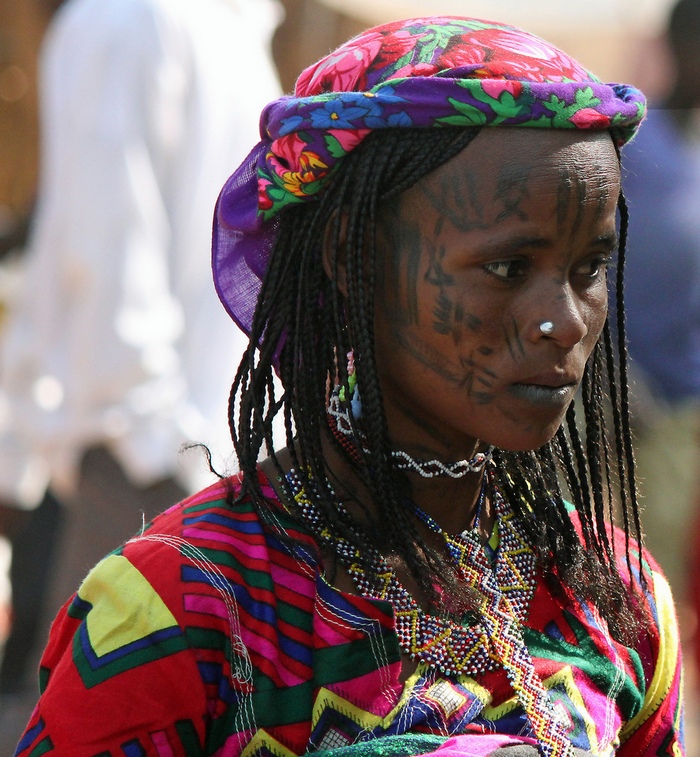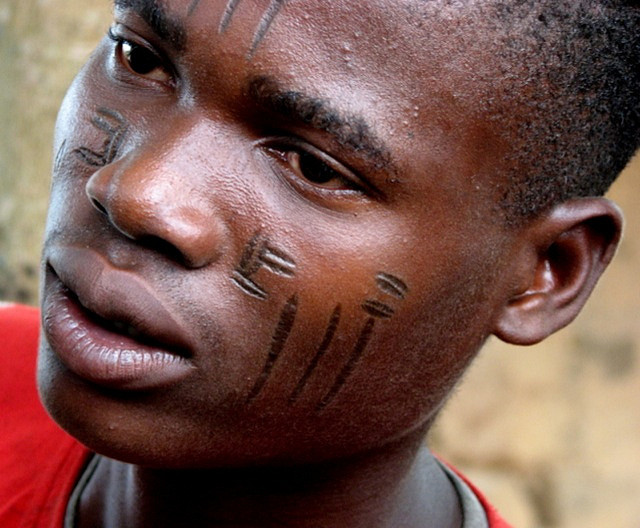My wife, Rejoice, was interested in getting a tattoo. When I asked her to show me tattoos that she likes on the Internet, she pointed to various examples.
I told her, "But, Rejoice, they're all tattoos on white skin. Many of those colors will be hard to see on your black skin. You ought to look at photos of blacks with tattoos and then decide if you still want a tattoo."
She was discouraged. She agreed that tattoos don't look the same when they're on a black skin - and her skin is nearly black, not the chocolate color that most African Americans have.
Rejoice remembers her mom, who had cicatrization on her face, her lips, and arms. Her mom wanted to make similar marks on Rejoice.
However, her dad objected. He threatened, "If you put tattoos on my daughter, I'll take you to court!"
Rejoice never got her cicatrization.
Still, her fascination with tattoos remains. So when Dan Hunter asked to write a guest post, I knew Rejoice would enjoy it. I hope you do too.
Guest post by Dan Hunter of the Tattoo Authority
These days, the vast majority of tattoos across the world only go skin deep, so to speak. Their main purpose is to only 'look cool' - sometimes with some sort of sentimental backstory to further cement their purpose.
But in Africa, this was never the case, and it still isn’t in most regions. The ideologies behind most tattoos in Africa go much deeper than pure aesthetics.
The History Of African Tattoos
For many thousands of years, tattoos were seen as a way of curing disease, protecting against spirits, showing affiliation towards certain groups/tribes, and reflecting personality traits such as bravery, courage, and social status.
These tattoos were predictably very simple in design. They consisted of pairs of straight lines on the arms and legs of the priestess and also included an elliptical pattern beneath the navel (belly button) area.
The oldest tattoo every found was on an Egyptian mummy around 2000 BCE. Besides this discovery, many other mummified tattoo examples have been revealed and documented. One Egyptologist believes these tattoos could have symbolized and represented rejuvenation and fertility in women.
However, many male tattoo-baring mummies have also been found in Egypt and in other African countries such as Libya, with many of these tattoos looking as though they were created in order to show commitment and devotion to sun worship.
In fact, excavations of the tomb of Seti uncovered the bodies of men with tattoos that are predicted to symbolize Neith, the goddess who fiercely led many warriors into battle. These examples date back to around 1300 BC.
Tattoos In North Africa
Although there has been a large presence of Islamic societies within North Africa throughout its history (who do not support the ideas of tattooing or otherwise engraving on the body), there were many who considered the art form of tattooing to be a legitimate practice - especially large groups of Moroccan women for reasons currently unknown.
Most within this region though decided not to disobey their faith. Throughout the centuries, strict Muslims saw (and still see) tattooing as being highly disrespectful and unholy. This is because the practice is seen as causing injury to the body, which would be seen as graffiti on a gift from god.
However, early 20th-century documentation suggests that there was still a sizable traditional tattoo culture throughout recent history in parts of North Africa, including Morocco, Algeria, Tunisia, Libya, and Egypt.
Tattoos In Sub-Saharan Africa
Although it appears that tattooing culture as we know it never gained any noticeable historical attention in the Sub-Sahara, it was found that small groups of indigenous people from these regions did practice a form of body modification called skin scarification.
The process of scarification involved using a sharp instrument to cut the skin deeply enough for a scar to form over the area. Sections of skin were sliced into shapes and patterns so that when the skin healed and scarred, the shape/pattern would remain forever.
This was considered a dangerous practice many years ago due to the lack of suitable healing methods in these times. If any new tattoo or scarification practice was undergone, then the lack of available tattoo aftercare advice and procedures meant that many people suffered greatly from infections contracted through the puncture wounds within the skin - even quite commonly causing death if not treated quickly enough.
Given the superstitious nature of many indigenous people from this area, many of these practices were drawn and provided in order to create a protective barrier against various forms of evil and harm that may be presented to a person throughout their life.
Tattoos In Present-Day Africa
Interestingly, in more modern times within Africa, the art forms of tattooing and scarification have actually merged in many countries to create a process called cicatrization.
Cicatrization involves cutting the skin deeply to create scar tissue before then rubbing ash or soot into the wound. Whilst the ash/soot does add pigments of color to the scars as they form, the main purpose of adding these elements to the area is to inflame the skin, causing the scars to raise and protrude even more than they normally would.
Sometimes, the scars are even re-opened at a later time only for pebbles or pearls to be added underneath the skin to create an even more visible raised effect.
This process is sometimes used as a ritual within various tribes. Although all tribe’s will have at least small differences within their ritualistic styles, for many boys within these tribes, they will have to undergo cicatrization as they hit puberty, and as they proceed to approach manhood a few years later, their scars will be reopened in order for stones/pearls to be inserted to further raise their shapes and patterns.
REJOICE INTERJECTS: In Rejoice's Fulani tribe (which exist throughout the Sahel), they use the sharp thorn of a tree that in the Hausa language is called aduwa. Your mom or grandmother will use the aduwa thorn to make micro-incisions on your lips and face.
The Kanuri and Hausa tribe has men called wanzam who are specialists in making cicatrization. They often have 10 different types of razor-sharp knives that they use. They cut your baby in the design that your tribe prefers. Then they apply a mixture of powdered charcoal and aduwa oil on the baby over the next few days until it heals.
‘Normal’ tattoos are much more commonly seen in many African countries these days when compared to centuries ago as well. There is also much more variance.
Whilst many tattoos represent and portray important symbols and beliefs, many are also purely for decorative purposes and portray only personal significance (as opposed to the local/regional duties of wearing a specific style of tattoo).
However, there are still many areas and cultural groups where power within society is everything. If a person is deemed as low ranking within their tribe/social group, they may only be allowed extremely basic tattoos (namely just simple lines and shapes).
On the other hand, high-ranking leaders such as chiefs commonly have elaborate and highly detailed inkings to display their powerful stature. Normally, as a person increases in rank/structure, their basic tattoos are redesigned and added to in order to make them more detailed and complicated.

Summary
Due to this being a rather unusual and uncommon subject, many people will have little knowledge with regard to the history behind traditional African tattoos and tattooing procedures - and many will likely never have given the subject much thought.
However, there truly is an extremely colorful tattooing past within this great continent - and the deeper you look, the more interesting it becomes.
Next time you see an interesting tattoo, especially if you’re traveling around Africa, just think for a moment about the potential history and meaning that could be behind the very piece of ink you’re looking at.
About the Author: Dan, a Master of Fine Arts and a participating member of the tattooing community for over 10 years is the resident writer at Authority Tattoo. While no longer as active in the tattooing community, Dan still attends many tattoo conventions around the country and is here to help educate, teach and advise readers on all things tattoo related. Find him on Twitter and Facebook.
Photo credit: Carsten ten Brink, Flickr





